Abstract
This study examines the utilization of solar panels in the houses of Abu Dhabi city. A presentation of applicable solar power scenarios is displayed on a global scale. Furthermore, solar power applications in Abu Dhabi city are briefly demonstrated. In light of the depleting state of oil-backed energy sources, this study further investigates the social acceptance of homeowners in Abu Dhabi to install solar panels in their private houses, and identifies the main reason and the optimal scenario to achieve it. Importantly, this research solidifies the objectives with a related survey that was sent to 216 interested individuals residing locally in Abu Dhabi city, over a time period of 2 months. The survey, in the main, presents four scenarios that could stimulate interested individuals to change to the use of independent solar power systems in their houses. The results are displayed in detail to show the different opinions of homeowners in the city of Abu Dhabi, and an in-depth discussion follows afterwards, proving a high interest in solar power. The results of the survey emphasize that the most preferred scenario is to have authoritative financial support in the process of solar panel implantation. The conclusion confirms that the rising social acceptance status along with the elected scenario could stimulate the possession and utilization of solar panels in private villas and houses in Abu Dhabi city.
1. Introduction
Abu Dhabi is well known for its scorching sun and hot climate, which is naturally rich in solar energy, making it an interesting environment for green energy if all suitable conditions are available. The same applies to other emirates in the UAE. For instance, the city of Dubai generates 44% of its electricity from renewable energy, which is almost half of its consumption, meaning that the gas consumption that used to take place in powering the other 56% of city power has become obsolete, in the hope of saving power and saving the environment [1]. However, the current situation in Abu Dhabi city proves that there is a high dependency on natural gas combustion to generate power, which can reach up to 80% of the power generated in the capital city [1]. Therefore, based on these data, opportunities must be seized for the betterment of the renewable energy field, and, particularly, solar power projects, as they can majorly reduce the consumption of fuel when generating electricity through photovoltaic solar panels. Solar power is one of the most widely used renewable energy resources to generate power in an eco-friendly process. Furthermore, the behavioral nature of local homeowners must be taken into consideration as is analyzed in this research study. Hence, this is analyzed after using various methods to evaluate the development of solar power resources. The main basis for this study is the hypothesis that we can generate electricity through photovoltaic solar panels on private premises. The main assessment is made based on several possible scenarios and formulas to generate solar power in residential houses, which would make this project feasible in the city of Abu Dhabi, as is the case for many solar power projects worldwide [2]. Thus, the research targets numerous possibilities to enhance the use of solar power consumption in the city of Abu Dhabi, which can be achieved by different scenarios, such as allowing private solar panel distribution to villas and townhouses throughout Abu Dhabi. The distribution of solar panels should be certified by the water and electricity authorities, which is conducted by the Abu Dhabi Distribution Company (ADDC), Abu Dhabi, United Arab Emirates, to eliminate possible future risks to the quality and durability of photovoltaic panels’ cells [3]. The current standardized amount of electricity usage as per ADDC is 400 kWh daily (based on the local tariff), which is considered to be eco-friendly usage, and any consumption above 400 kWh is considered to need a higher tariff to ensure the importance of using electricity efficiently. Moreover, a small number of solar panels can generate roughly 10–20% of this electricity, resulting in a reduction in gas-backed electricity consumption to 80–90% [4]. The main objective that is pursued during this study focuses on the utilization of sustainable energy resources in the city, along with introducing homeowners to the technology of photovoltaic solar panels. The statistical status in Abu Dhabi proves that there is a high dependency on natural gas combustion to generate power, which can reach up to 80% of the power generated in the capital city. Hence, increased utilization of solar power in the city will allow energy saving and protection of the environment by reducing fossil fuel combustion. The major drawbacks of excessive fossil fuel use are further depicted in the examples used during this study. Nonetheless, such a project cannot be validated without understanding all the prominent aspects in the renewable energies field [3,5]. Additionally, the discussion of renewable energy and its applicability in the city of Abu Dhabi is thoroughly investigated. The main objective is to clarify the most possible and applicable scenarios where solar energy can be utilized accordingly in the city of Abu Dhabi. Moreover, the research sheds light on electricity generation and energy consumption risks that might be challenging, such as the possible degradation modes that can take place on the solar panel cells when being directly affected by constant natural incidents such as humidity [6]. Then solar power is discussed as a type of renewable energy, along with the current social acceptance and preference for solar panel installation and implantation by homeowners. The offered formula in the survey shows the path that Abu Dhabi city has to follow like other cities that are adjusting solar power projects in private houses, as is the case in many countries worldwide, which aim to adapt the demonstrated micro-grid systems into hybrid house models for homeowners [7]. Similar projects have been adapted in India and in Sweden in the form of self-sufficient systems, which function depending on the solar power generated by solar panels only and stored in batteries. Consequently, the current tariff details in the UAE (specifically through the Abu Dhabi Distribution Company) are explained in relation to the survey questions and statistical data that have been proven along with the references to clearly solidify and support the main research study objectives.
2. Literature Review
2.1. Electricity Generation Challenges
2.1.1. Main Challenges
Electrical power is a practical necessity for the economic success of society. The Earth has had to confront severe energy issues at the start of the twenty-first century. The notion of sustainable development has emerged for a livable future in which human needs are addressed while nature is kept in balance. To begin with, electricity generation methods, such as direct current systems, were first known in the late 19th century. Consequently, smaller electricity generation methods were marketed for international enterprises for industrial and mining usage, both in metropolitan areas and in distant underdeveloped areas. The major attempts to electrify the planet were led by Thomas Edison and Werner von Siemens. Although this invention energized the industry and only a few districts, it failed to cover all the inhabitants. Hence, it was evident that in order to convert an idea to provide enough electricity that covered entire towns into reality, the electricity would have to be generated in one location (such as a huge river with significant hydropower potential) and transmitted to the city [8]. Originally, when rural families lacked access to electricity, it was generated at far-off hydroelectric plants or by the combustion of fossil fuels in populated areas, supplying it to local structures and then using the leftover heat to create steam to heat those same structures. As coal plants grew over time, pollution pressure forced them to be located away from population areas. Many kilometers of transmission wires transmitted power with a 10–15 percent loss. [9]. The heat was removed since it is impractical to convey waste heat across large distances. The wasted heat was a trade-off for cleaner air in cities because there was no practical technology for clean, local generation. The power industry eventually built a sizable system and put new generators on remote sites far from its clients. Every plant was individually created and constructed on-site, resulting in cost savings. Building big plants costs less per unit of generation than building smaller ones [8]. From 1910 to 1960, these conditions prevailed, and everyone in the energy industry and the federal government began to think that distant, controlled generation was perfect and that it would generate electricity for the least amount of money compared to alternative options [9].
2.1.2. Financial Struggles
The main source of power that puts electricity into existence is gas, as it is considered the most commonly used energy source to generate electricity worldwide. Hence, gas is as important as water and food because without gas generating electricity, we would not be able to perform our daily life activities such as turning on the light in a room, charging our mobile phones, or using the stove; so, basically, gas has been reshaped in theory from being a fossil fuel type that is created after the decomposition of plants and animals, to having a fundamental basis in our civilization and being a necessity for all human beings on earth [10]. Everything around us operates through an electrical device or partially electrical device, and that leads us to investigate the current state of electricity generation and if there are any risks of losing it. Electricity is generated by burning natural gas after being extracted from underground in offshore and onshore locations [11]. The struggle that needs to be addressed is the linear increase in gas prices over the last decade worldwide [12], consequently raising concerns about the possible risks that may come into existence in the near future if gas prices were to increase further without setting a limit [10]. Gas prices control the permitted consumption and electricity tariffs in all countries; increased prices might not affect organizations, but they will affect individuals, as some might face the challenge of keeping up with the increasing utilities bill that with time will be challenging to low- and middle-class households and eventually to those of higher classes as well if they were to increase nonstop. Another aspect that affects gas prices badly is political events and wars, which can lead to a disruption state in the supply and demand ratio of gas, forming many predictable bad scenarios for gas prices and usage afterwards, subsequently altering the chosen default options to generate electricity [10]. In simpler terms, if gas is expensive, it is more likely for people to use it less, and the scale can narrowly affect individuals and widely affect countries.
2.1.3. Climate Changes
Fossil fuels currently meet most of the world’s energy needs. However, the great weight of the scientific data points to the unrestrained usage of fossil resources that is creating global climate change with potentially disastrous consequences. Until the 20th century, everybody in the electricity sector and the authorities assumed that distant, pivotal electricity generation was ideal and that it delivered energy at the cheapest prices compared to other options [8]. They are susceptible to supply chain disruptions due to their high level of integration. This supply paradigm is becoming less appealing, especially when it comes to power. In addition to their fragility, centralized energy supply systems are becoming less popular because of a variety of bothersome issues, such as the exhaustion of fossil fuels and the impact they have on climate change, as well as the insecurity of the infrastructure for energy transportation, investors’ desire to reduce risks, and the use of more compact, modular generation and transmission systems [8]. Therefore, there has been an obvious increase in fuel prices internationally due to the realistic fears of fuel depletion in the future. In addition, the constant increase in the population worldwide overloads the demand ratio over the supply for energy generation as well as the occurrence of unnatural global events such as global warming, which is majorly caused by large releases of carbon emissions along with other air pollutants that interact with the atmosphere [13].
2.1.4. Need for Sustainability
Electricity is mainly generated by the combustion of natural gases, which can generate electric power. Nonetheless, as a global fact, gas combustion has resulted in many environmental crises, such as global warming and an increased amount of carbon emissions [13]. Here comes the eco-friendly initiative of green energy, which is meant to provide power from natural elements rather than one-time-use sources such as gas and petrol [14]. Sustainability has been applied in many sectors in our daily lives as it has many forms and functions. Sustainable energy can sometimes refer to green energy. An example of sustainable energy can be solar power and windmills. However, these energy generation methods are assessed by their capability to operate in a continuous manner throughout different sectors that require energy [15]. Hence, sustainable energy can be differentiated from renewable energy. For instance, crop planting is an example of renewable energy where it is always renewed through a routine procedure. However, sustainable energy is unceasingly sustained from natural elements such as sunlight [16]. By transforming the forces of nature into usable forms of energy, renewable energy sources offer marketable energy. The power of the sun, its direct and indirect effects on the globe (such as solar radiation, wind, falling water, and a diversity of plants, such as biomass), gravitational forces (such as tides), and the heat from the earth’s core are all factors that are used to power these devices (geothermal). These resources offer a huge amount of energy potential, but they are frequently scattered, not always accessible, with many of them intermittent, and there is a lot of geographical variability. At the present time, great development is being achieved in terms of boosting the collection and conversion efficiency, cutting operation expenses, and enhancing dependability. Over the last two decades, there has been a worldwide effort to create and conduct research in the area of renewable energy sources and systems utilizing modeling, optimization, and simulation technologies [8].
2.1.5. Self-Sufficient Houses
A model-based study was carried out for solar panel installations in Swedish households using real-world household energy consumption data from 2104 single-family dwellings [17]. Furthermore, in order to investigate the extent to which a battery could help to increase photovoltaic electricity self-consumption, which is the amount of photovoltaic-generated electricity that is consumed in-house, the study aimed at self-sufficiency, which is the fraction of electricity used by the household that is not bought from the grid. The study aimed to optimize self-sufficiency, and, as a result, photovoltaic power self-consumption for 122 alternative combinations of solar panel capacities and battery capacities for the 2104 households. A battery with a relative battery capacity of 2.5–4.0 kWh (defined as the battery energy storage capacity in kWh divided by the expected annual electricity output of the solar panels in MW/h) can increase the PV electricity self-consumption of Swedish households by a practical maximum of 18–48 percentage points. As an example, a family home with a yearly power use of 20 MW/h and a photovoltaic system of 7 kW would need batteries of a large capacity, perhaps in the range of 15–24 kWh, in order to accommodate this difference in relative battery capacity, that is actual usable capacity; as shown in Table 1 [17]. It is fair to expect that the highest capacity of batteries that may be put into Swedish households to increase self-consumption and self-sufficiency will fall somewhere in the range described above; hence, a relative battery capacity of 2.5–4 kWh.

Table 1.
Self-sufficient households’ study.
2.2. Social Acceptance
2.2.1. Ecological Behavior
In democratic communities, the problem is that rational individual behavior may not be consistent with the common good and may limit the effective use of public resources. Expert opinions as well as public sentiment and perspectives are considered as inputs to the planning and decision-making process [18,19]. Hardin notably mentioned this dilemma in his book The Tragedy of the Commons (1968) regarding the prisoner’s dilemma, an imaginary model that illustrates how the equilibrium solution, which is preferred by individual players, varies from the cooperative solution, which is optimal for society [20]. However, if emotions or opinions, for example, perspective, did not influence conduct, that can be irrelevant. As a result, an intriguing issue emerges requiring those merits to have more investigation: Is conduct related to attitude? Paravantis [21] provides a concise summary of the linked literature. The term “attitude” refers to a person’s evaluative opinion of a certain notion or item [22]. The beliefs, values, and actions that a person has about environmental concerns shape their mental attitude [23]. It is difficult to define environmental attitudes precisely, making it a challenge to forecast ecologically sociable behavior [24]. According to the concepts of deliberate action and behavior, behavioral intention comes before explicit behavior [25,26]. Environmental knowledge, environmental values, and intended ecological conduct are all considered to be components of the complex construct known as environmental attitude. To predict ecological behavior, the theory of planned behavior emphasizes aspects of conduct that are beyond willed control [27]. There is a high association between environmental attitude and the desire to engage in ecological behavior. According to the idea of planned behavior, there is a relationship between environmental values and ecological behavior, which is most likely mediated by a third component called ecological behavior intention [28]. To summarize, people progress along a continuum of environmental knowledge competency, with phases including awareness, concern, comprehension, and action [21,29]. Yes, behaviors do, in the end, follow attitudinal views. As a consequence, it is established that it is critical to understand electricity users’ views since their attitudes serve as the foundation for their subsequent behavior [30]. Three particular criteria appear to underpin public behavior: public knowledge, public views, and anxiety; as an example, worry worsens with unawareness [18,31,32]. These should be looked at further. Let us turn the focus to the public’s perceptions regarding RES (renewable energy resources). To be sure, local people, regional governments, financial institutions, nongovernmental organizations (NGO’s), and localized communication systems appear to be participating in RES initiatives [33]. Despite their disparate opinions and competing interests, these players must find ways to collaborate. Cohesion, the removal of personal interests, and having accurate information and being represented, as in the case of including all parties in the decision-making procedure, are all requirements for collaboration [32,33]. Participants from the private and governmental sectors are encouraged to develop commercially viable and socially acceptable sustainable technology. According to Assefa and Frostell [18], social impacts have an impact on the entire society as well as on each individual member. They are followed by public acceptance, which is a critical element of sustainability. The NIMBY (Not in My Back Yard) phenomenon, on the other hand, refers to opposition to a project that is unpopular with the neighborhood [32,34,35], and it can lead to social strife and economic losses [19]. The opposing phenomena is known as PIMBY (Please in My Back Yard), and it is thought to happen when a plan is perceived as useful (for example, as a source of money) and favorably appreciated by similar societies [19,36]. One critical factor that should be discussed is the current social acceptance for green energy utilities in Abu Dhabi. In previous years, there have been events and initiatives in the city of Abu Dhabi held by private and public establishments to introduce green energy to companies and governments as a futuristic substitute for the energy that is generated from fossil fuels [37]. In return, solar acceptance has been fairly accepted by people in Abu Dhabi through public events such as the World Future Energy Summit (WFES), which is held on a yearly basis in the city; it focuses on new technologies and methods to generate energy that are efficient and eco-friendly. Such events have many participating companies and visitors as well as potential investors interested in green energy [38].
2.2.2. Interest vs. Awareness
According to one study that is thoroughly investigating the awareness level of clean energy, such as solar energy, using photovoltaic panels demonstrates the high awareness among residents of the UAE of the need to further utilize clean energy means. However, despite the high awareness highlighted in the study, further promotion is required to increase the interest in solar energy [39]. While awareness is thought to be high, social interest is considered quite low among residents, who must be motivated to achieve a sustainable city. In sequence with the 2050 vision of the UAE, the study sheds light on the aim to reduce fossil fuel consumption and to successfully achieve 50% clean energy utilization by 2050 [39]. Findings of the study imply that motivating interest can play a critical factor for residents to increase their utilization of photovoltaic panels. As per the investigation, the additional utilization of solar energy can lead to a 73% decline in the current reliance on electricity grid consumption. Nevertheless, further elaboration is made on the lack of awareness among developers and electrical service providers, which subsequently influences decision makers negatively in choosing clean energy sources. The study also indicates that promoting clean energy means to the public may encourage the willingness of residents to buy and install photovoltaic solar panels. The study concentrates on the level of acceptance in building integrated photovoltaics because it is believed to have the potential to affect the design stage in new buildings for investors and owners. In summary, the study discovered that the acceptance of solar power integration with buildings is directly associated with public awareness of green energy methods and public interest as well, indicating that the relationship addressed is proportional in terms of the influence on UAE residents [39]. Green energy is more likely to fascinate locals when public awareness is constantly promoted among the public to achieve renewable energy sources for new buildings.
2.2.3. Current Electricity Tariff
Founded in 2005, the Abu Dhabi Distribution Company (ADDC) is a subsidiary of TAQA Group, which was established in 2005. It is mainly known as the Abu Dhabi National Energy Company [4]. The Abu Dhabi Distribution Company is regularly known to be a semi-governmental entity that is entitled to distribute water and electricity services in three categorized locations: Abu Dhabi Island (which is the capital city), Eastern Abu Dhabi (Baniyas, Shahamah, and Mussafah, and Western Abu Dhabi (Liwa and Silla, which is also known as Western region of the UAE). The current solar energy initiative that is proposed sheds light on the pre-approval of solar panel installations that can be carried out at houses. Similarly, a new initiative has been launched by the Abu Dhabi Distribution Company (ADDC) that plans to educate tenants and owners to use less water and electricity by reducing excessive and unrequired consumption [37]. The initiative is called “Tarsheed”, which is an Arabic word that means to use less and efficiently. It aims to reduce the total energy consumption in the city of Abu Dhabi as a means to sustain the natural resources available and utilize them in a sense that makes generated energy sufficient for everyone living in the city. To further examine the electricity consumption in Abu Dhabi city, local tariffs were intensively explored to emphasize the allowed and actual consumption rates, reflecting either a green or a red band on the bills as per the Abu Dhabi Distribution Company (ADDC), as shown in Table 2.

Table 2.
Green and Red Consumption Tariff.
As is stated on the website, “Our residential tariffs are designed to encourage sustainable consumption. They are divided into two different rates that affect your total bill. The green band is charged at a lower rate, up to a set daily allowance based on a calculated ‘ideal average’ consumption. If you use more than this limit, you will be charged at a higher red band rate. So, if you stay in the green, you’ll pay less for each unit.” [40]. The accepted average daily consumption is referred to as “green brand”, which refers to sustainable consumption. The consumption of electricity for houses is up to 400 kilowatts per hour. Green band consumption refers to the government-backed electricity tariff since it is considered eco-friendly usage, making any consumption above that calculated as red band consumption, which results in an extra charged tariff that is a little bit higher. The green consumption tariff is 6.7 fils for 1 kWh and is usable for up to 400 kWh for houses in local tariffs. The red band consumption tariff is 7.5 fils for every extra 1 kWh. Thus, the red band consumption tariff is charged against the usage that exceeds the ideal green band consumption limit for apartments and villas.
2.2.4. Opportunities and Ambitions
One of the advantages the UAE has is being the only country in the world with the most sunlight exposure. This fact drives new and current opportunities to be further researched and developed into tangible methods to generate solar energy, hence reducing fossil fuel consumption through the generation of alternative clean energy that produces electricity more efficiently [41]. According to a recent study that reviewed the clean energy projects in the country, solar energy is believed to be the most abundant form of clean energy in the UAE. Relatively, photovoltaic technologies are noted as a growing source of power that is achieving the current local requirements for energy consumption. As a further demonstration, the UAE government is constantly proliferating clean energy generation projects in the country to familiarize locals and to achieve a sustainable energy system in the future [41]. In return, the ambition has also been expanded to achieve a clean environment with a reduced carbon footprint and the reduction in other pollutants that negatively affect the ecological system. Among increasing concerns about energy generation risks worldwide and a predicted energy catastrophe, which might become inevitable to face if the current clean energy opportunities are not taken into further consideration, it is very important to indicate the serious steps that are essential to transition into clean energy generation methods. According to the study, which discusses UAE solar energy projects, Abu Dhabi covers 84% of the total land area in the country, ultimately enabling the capital to utilize the high sunlight exposure to convert it into electrical power to be consumed by residents in the cities [41]. Moreover, the review study stresses the need to widen research on solar energy in universities and institutions as a necessity to evolve the current solar energy technology and applications in the country. Photovoltaic panels can comparably reduce the current costs of generating electricity due to the direct process of using solar panels to capture sunlight and the ability they have to transform sunlight particles into electricity with low costs because they only require the solar material to be set up, which, in sequence, requires further research work in order to seize the maximum amount of renewable energy possible.
2.3. Solar Energy Applications
2.3.1. Modern Day Applications
Current-day solar panels have become very popular worldwide since they generate electrical power from sunlight, which is converted to a sort of energy, scientifically called solar energy [42]. Solar panels were first noted by a French scientist in the 19th century. He was able to observe the light particles, known as photons, in sunlight that affect a specific type of surface differently, such as silicon. This discovery allowed further investigations to take place into this matter. As years followed, it was also developed further by Albert Einstein, where he was able to identify the photoelectric effect, as he named it. The effect takes place differently depending on the surface hosting the light particles of sunlight. The discovery of this effect saw the possibility of absorbing the photons and capturing the electric charges on a semi-conductor surface, resulting in an electric current. Hence the name, the photoelectric effect [42]. One particular aspect to emphasize is that this effect has been utilized in mini semi-conductor materials where it allows the capturing of light particles to create an electric current and voltage that can pass to a connected battery to save the captured electrons and create a voltage. These semi-conductors are called photovoltaic cells, which make up solar panels [43]. Solar panels consist of small photovoltaic cells connected to each other, creating solar panels that generate solar energy from voltages derived from the photons of sunlight [42]. More importantly, when combining these solar panels together, we create a solar array that includes multiple solar panels. On a larger scale, there are real applications of solar energy, which have been used in many countries in different sectors. For instance, it has been used privately in the United States of America by farm owners in the south, where they were given the chance to invest in their farming lands [44]. Thus, instead of planting and cropping, they created “solar farms” that included hundreds of solar panels being laid down next to one another, generating solar power that goes directly to the utility grid and large batteries to be sold to the government. In Europe, solar panels have been regularly bought by homeowners to be implanted on the rooftops of their houses to generate solar power that is sold to the governmental electricity grid [45]. In this case, solar panel owners generate and sell electricity and make a profit out of it. However, they pay for their electricity bills as normal. People nowadays have more confidence in investing in sustainability initiatives as more global electronics companies are manufacturing and selling solar panels and investing in green energy. For instance, the famous electronics company LG has been selling solar panels based on different options to its customers in the United Kingdom [46]. In addition to LG, a competitive number of companies have enrolled in the same field of green energy. This has allowed for more research and development in this area, as well as allowing concerned scientists to further explore and investigate the efficiency and liability of the panel [47]. In the United Arab Emirates, local initiatives have taken place in some sectors to save the environment, for example, the applications of photovoltaic solar panels in the UAE can be seen in many agricultural projects in the city of Abu Dhabi. As an example, the agricultural system on Hafeet mountain relies solely on solar panel arrays due to the bright sunlight that hits the mountain without any blockage, which is supposed to generate enough electricity to power the water pump connected to the tanks above placed on the 1200-m-high mountain. Its main purpose is to absorb sunlight and generate electricity that will pass through a distribution board to regulate the electric current flowing to power the water tank pump, which is connected to multiple pipes, creating the water network that is used in this unique agricultural project, as demonstrated in Figure 1 and Figure 2.
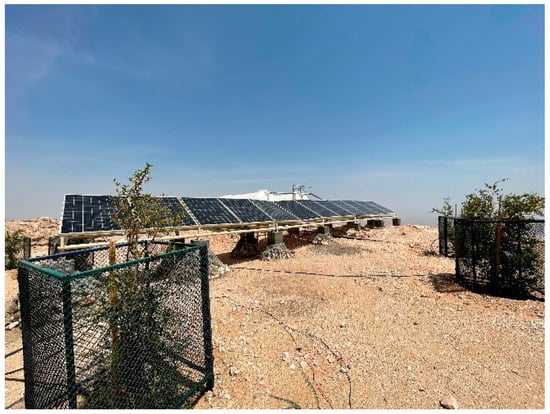
Figure 1.
Agricultural project at Hafeet mountain in UAE powered solely by solar panels.
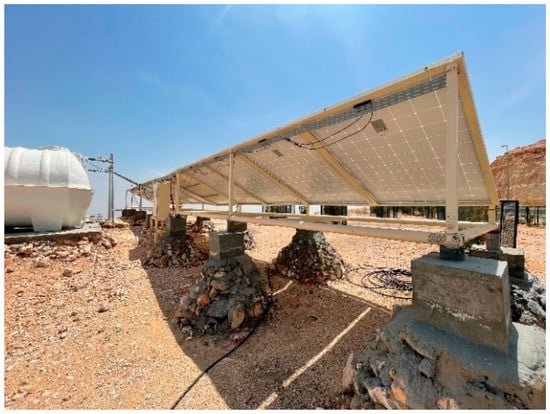
Figure 2.
Taken at Hafeet Mountain for the water tanks powered by solar panels.
As show in Figure 2, the water tank above the mountain is independently powered by the arrays of solar panels installed. Furthermore, One of Abu Dhabi’s sustainability visions is to host the largest solar farm in the world. The upcoming Al Dhafra solar project is estimated to power roughly 160,000 houses across the city of Abu Dhabi. It will be the first independent power producer to generate 2 gigawatts of power from photovoltaic cells. The land is estimated to reach a length of 35 km, making it the largest solar power generation field in the whole world. Similarly, a solar project is currently underway in Masdar City, the sustainably powered city inside of Abu Dhabi. The project is supposed to generate solar power and store it in large batteries for future usage.
2.3.2. Resources Competition
In the current situation, some of the ways to generate renewable energy would be through either nuclear energy or other renewable energy resources. Nuclear energy, contrary to fossil fuels, does not generate electricity through combustion processes but rather through fission processes that produce heat, which is simultaneously used to create steam that will be later used in a turbine generator to finally produce electricity [48]. Fission refers to the chemical process of splitting atoms of uranium. The required uranium for this process is a highly unique type and is also nonrenewable [11]. However, despite its convenience, nuclear energy does produce radioactive waste, and although it does not pollute the air or produce greenhouse gases, it is extremely harmful to both human health and the environment, hence the need to keep it in safe long-term storage. The mentioned challenges shed light on the importance of researching new ways to generate electricity, perhaps with less cost and fewer risks to health and the environment, such as renewable energy sources [48]. There are various types that have been utilized in the past decades. As per the United Nation article on renewable energy, there are six major types of natural energy sources: solar power, windmill energy, hydropower, geothermal energy, ocean energy, and bioenergy. This article points out as well that solar energy is the only one that exists in large amounts in comparison to the other renewable energy sources, making it an abundant source of renewable energy [48].
2.3.3. Abu Dhabi Solar Energy Plan
The Abu Dhabi Distribution Company (ADDC) is constantly working on implementing solar energy, especially for those individuals who are concerned about sustainable energy and are willing to install solar panels on the rooftop of their homes. The procedure that is officially registered on their website states that the process is similar to applying for a new electricity meter, where the premises’ owner is supposed to contact a certified contractor, and then the contractor carries on the regular requests with ADDC until the service is powered. In normal electricity meter installation cases, the first step for the responsible owner is to contact an ADDC-certified contractor to work collaboratively along with the ADDC engineers to activate the service at home. The procedure includes pre-inspection visits to ensure that there is sufficient and convenient space prior to the installation; then the contractor agrees with the certified consultant to design the installation, which is submitted to ADDC for internal approval; and after the solar panel meter is installed, the final request is applied for by the contractor to activate and supply energy. Once the supply starts running, electricity is metered regularly, and readings are taken monthly to issue the electricity bills.
2.3.4. Humidity Impacts on Solar Panels
It is necessary to take into account two possibilities while studying the impact of humidity. The first scenario involves the impact of water vapor particles on the amount of sunlight irradiance, while the second scenario involves humidity infiltration into the enclosure of the solar cell. There are three possible outcomes when light strikes water droplets. It might reflect, diffract, or be refracted. The direct solar radiation component’s reception level is reduced by these factors. Irradiance is affected nonlinearly by humidity, and irradiance produces small linear fluctuations in voltage and huge nonlinear variations in current. Hence, the efficiency of the power output decreases when dampness reduces the current, even though dampness has smaller impact on voltage [49]. The reasons for the nonlinear variations in irradiance with relative humidity are the nonuniform distribution and vast range of water vapor particle sizes in the environment. Smaller water vapor particles provide greater scattered angles. A greater number of water vapor particles in the atmosphere also causes more diffraction. It is undeniably true that tropical nations such as Malaysia will see a depressingly greater decline in irradiance levels due to their much higher relative humidity levels. Relative humidity is negatively impacted by wind speed, which has an impact on received irradiance [49]. Moisture ingression is examined in the second strategy for understanding how humidity affects solar cell performance. Long-term exposure to humidity results in some performance loss for photovoltaic cells [50]. In general, depending on the kind of PV technology used, there are two module failure modes. Crystalline silicon cells may fail at the cell interconnections or develop fractured cells, and failure at the scribe lines is the main factor degrading cell thin film modules. Therefore, for crystalline silicon cells and thin films, respectively, embrittlement of the encapsulant material and corrosive moisture are the key causes of the aforesaid degradations. These degradation processes may be accelerated by hot and humid temperatures [51]. Passivated PV cell surfaces cause current deterioration, which results in performance reduction, but have little to no impact on voltage [50]. Voltage may sometimes spike dramatically, which is unexpectedly weird. The fact that water droplets are confined within the cell and function as magnifying lenses to concentrate the sun is a plausible explanation for these phenomena. In a similar vein, water vapor particles serve as barriers that slow the pace at which electrons are produced by the cell by preventing incoming sunlight from exiting [50]. The use of edge sealants and the use of low ionic conductivity materials for the encapsulant are two preventative measures that may be implemented to lessen the infiltration of moisture into cell chambers [52].
3. Materials and Methods
3.1. Research Objectives
This exploratory investigation research aims to enhance the dependency on renewable energy consumption in the city of Abu Dhabi by exploring the social acceptance of solar panels within villas and townhouse owners in the city.
Therefore, the main objectives of the research project are to:
- Research the most up-to-date technologies related to solar power and renewable energy.
- Research the solar power generation scenarios applied around the world for homeowners to install solar panels and generate electricity.
- Conduct a quantitative analysis to examine the social acceptance of solar panel installation and renewable energy utilization in the city of Abu Dhabi by presenting 4 prominent scenarios to be chosen by the target audience in the city.
The main research question for this research project is:
To what extent is renewable energy socially accepted among villa and townhouse owners in Abu Dhabi, and what is their preferred scenario for installing solar panels?
3.2. Innovative Scenarios
Accordingly, after comprehensive research on the literature review of the application of solar power in the United Arab Emirates, there are several scenarios that can be taken into consideration when generating solar energy. The formula and scenario are based on specific criteria such as the solar panel owners, place of implantation, power required, and main purpose for the photovoltaic solar panels. Demonstrated below are the different types of scenarios to be implemented to obtain the most out of solar energy generation. In scenario no. 01, the solar panels generate electricity to power a residential house only. The responsible persons for buying and maintaining the panels are the homeowners, and this is the currently proposed option by the Abu Dhabi Distribution Company as per their solar energy plan. Hence, homeowners buy and install solar panels for personal use at their own expense if this will help them save money on their electricity bill. In scenario no. 02, homeowners buy and install solar panels for personal use, at their own expense, because this will help save the environment. This allows homeowners to give priority to eco-friendly initiatives that take place regularly in the city of Abu Dhabi. It further elaborates on the importance of taking into consideration the environmental status of the previous energy generation sources. In scenario no. 03, the solar panels installed generate power, delivering it directly to power the utility grid, which is the situation in many houses in Germany, as the government supports the use and installment of solar panels. Owners buy and install solar panels at their own expense, sell the produced power to the authorities, and pay the balance of their electricity usage on a yearly basis (this scenario is less expensive than the previous scenarios because no batteries are needed to store the electricity produced). In scenario no. 04, homeowners buy and implant solar panels for personal use if the cost is supported by the government (e.g., discounted, easy, and affordable installment plans, etc.). Subsequently, the scenarios, addressed and surveyed intensively, provide an overview of the four different possibilities to implant and utilize solar panels to develop energy generation in houses in the city of Abu Dhabi, whether they will be powering the utility grid or houses alone.
3.3. Homeowners’ Survey
Because there is little information available about the societal acceptance of solar energy in the UAE, this study was created as an exploratory investigation. More information about this subject might significantly increase the use of solar energy. The goal of this research is threefold. Firstly, this investigation investigates popular attitudes about the use of solar energy. Secondly, this study investigates popular perceptions of the challenges of utilizing solar power. Thirdly, this study examines civic perceptions of boosting solar power utilization in Abu Dhabi city. The inquiry in this paper makes use of the main and minor data in cooperation with the replies from the ground that were used as main data by using a survey approach. The information was gathered by delivering survey questionnaires (attached in the Appendix A and Appendix B) to Abu Dhabi residents and homeowners. The poll was taken between September 2022 and October 2022. The respondents’ rate of comprehension of solar power was disregarded when surveys were sent. Because survey answers may have come from a variety of backgrounds and the respondents may have had diverse amounts of experience on this topic, the language used in the questionnaires was plain and intelligible in both English and Arabic, with only a few technical terminologies. Respondents with a rudimentary awareness of renewable energy, on the other hand, were favored. Two criteria for participation in the exercise were considered in the survey’s sample design. The first criterion was that respondents lived in the wider Abu Dhabi area. The second criterion was that participants be at least 18 years old and property owners. Some generic questions were asked of respondents during the poll, such as their interest in environmental concerns, knowledge of global warming, familiarity with renewable energy technology, interest in solar energy, and so forth. As a result, only those who responded to the preceding interest with relatable data were chosen to answer the survey. A survey was developed to further demonstrate the social awareness of solar power in Abu Dhabi; the questionnaire involves essential questions such as gender, age, and marital status of the surveyed person. It also further inspects the current electricity consumption for villa owners and whether this is labeled under the ADDC’s green band consumption or red band consumption, depending on the type of premise they are using electricity in, the devices used in their homes, and the air conditioning system currently being used. The survey highlights the general knowledge as well as whether the respondent is aware of solar energy at all and if they are willing to support it by considering the use of solar panels soon. Another crucial question that was added focuses on the energy depletion incident that is taking place due to gas consumption and how inevitable it is for us to have to use a substitutional source of energy such as solar energy. Gas emissions were also deliberately added into the questionnaire to further understand the viewpoints and the range of knowledge of the respondents in general. The main audience that was targeted were homeowners, mostly postgraduate students and faculty, along with married and single men and women, to deeply identify the social acceptance status currently available in the city of Abu Dhabi among interested intellectuals. Using the data collected from the survey, a detailed result analysis was extracted that is neatly presented with charts, which demonstrate, by default, the information collected while also shedding light on the concluding projections of this survey’s data, based on homeowners’ opinions in the city of Abu Dhabi.
3.4. Study Limitations
The research study focuses particularly on investigating the social acceptance of solar power utilization for homeowners. The study is supported by a survey that was sent to 216 homeowners, which offered them 4 prominent solar power installation scenarios among other environmental aspects. The mentioned scenarios are applicable worldwide and are examined in the literature review. Therefore, the elected scenario is the key to stimulating the adaptation of solar power systems in the houses of local residents in the city of Abu Dhabi. Nonetheless, the role of research and development in the sustainability field always needs to be further observed and discussed to meet the higher substantial goals in the United Arab Emirates.
4. Results and Discussion
4.1. General Characteristics of the Respondents
The survey that was developed in this research project was conducted between September 2022 and October 2022 with the method of information gathering and surveyhero.com as the data collection platform. In total, 186 responses were received out of 219 surveys that were analyzed further using JASP 0.16.0.0 and Microsoft Excel. The utilization of solar energy was surveyed accordingly based on this background. The respondents’ characteristics, awareness level of solar energy, ability to buy and implant solar panels, and expectations of the governmental support to utilize solar energy in Abu Dhabi are discussed and investigated in this section.
4.2. The Interest and Importance of Solar Energy
The respondents involved in the study of the development of solar energy in Abu Dhabi were local individuals in the range of 18–59 years old. Two percent of the respondents were between 50 and 59 years of age and 5% were between 40 and 49, whereas 21% were between 30 and 39, and 72% were aged between 18 and 29 years old, as shown in Figure 3.
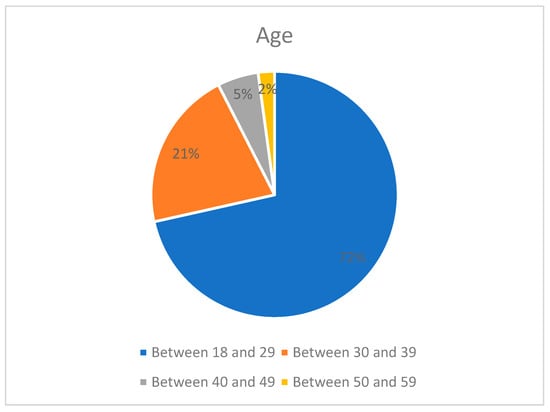
Figure 3.
Respondents’ age pie chart.
In terms of gender, the respondents comprised of 43% females and 57% males out of 186 responses, who lived in the province of Abu Dhabi, as shown in Figure 4.
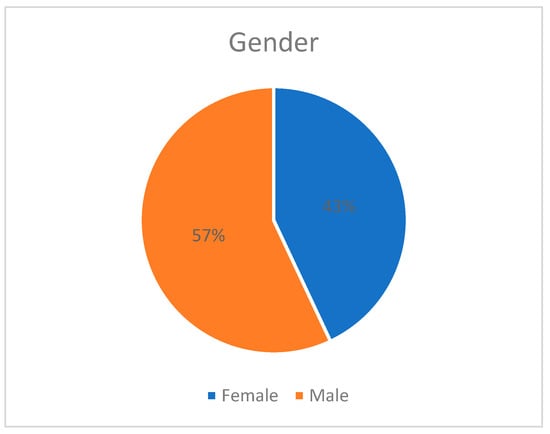
Figure 4.
Respondents’ gender pie chart.
As for the areas, only 2% of the respondents were in the Western region of Abu Dhabi, whereas 8% were in Al Ain, and 43% were in the Eastern region, the rest of the respondents were in the main city of Abu Dhabi comprising 47%, making them the largest group in the survey, as shown in Figure 5.
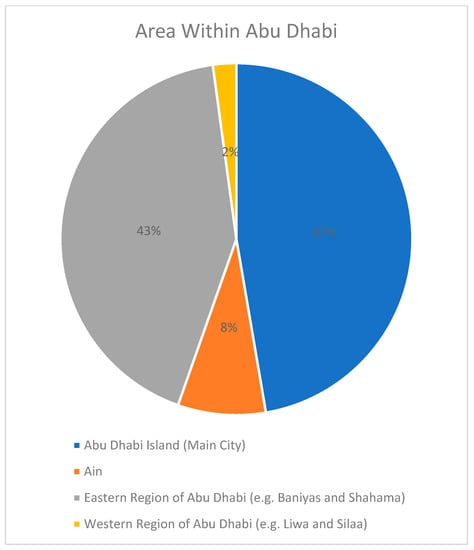
Figure 5.
Respondents’ area within Abu Dhabi pie chart.
The level of education of the respondents was also considered through the survey to assess their awareness on solar energy accordingly. The general levels of education were as follows: 1% of the respondents had a degree lower than a high school diploma, 2% had a PhD or DBA, 9% had been to college but held no degree, 10% held a high school diploma, 22% held a master’s degree, and 56% held a bachelor’s degree, as shown below in Figure 6.
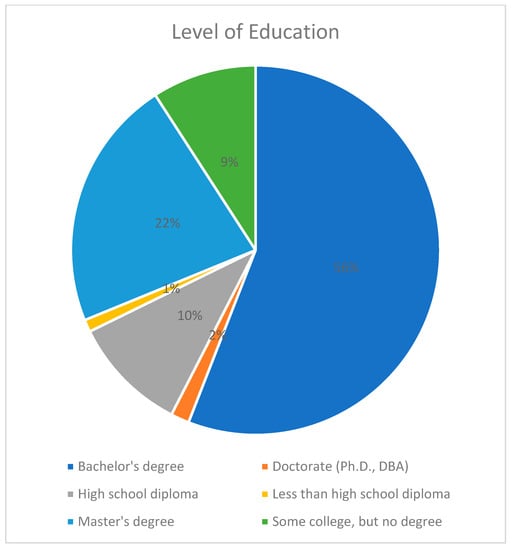
Figure 6.
Respondents’ level of education pie chart.
The financial status of the respondents was also included in the survey to demonstrate the financial ability of the interested respondents to buy and implant solar energy panels in their homes. The average household incomes per month of the respondents were comprised of 4% receiving a monthly salary of AED 60,000 to 89,999, 6% receiving a monthly salary above AED 90,000, 14% receiving a monthly salary of AED 40,000 to 59,999, 32% receiving AED 20,000 to 39,999 as a monthly salary, with 44% receiving a monthly salary of AED 0 to 19,999, representing the majority of the respondents, as shown in Figure 7.
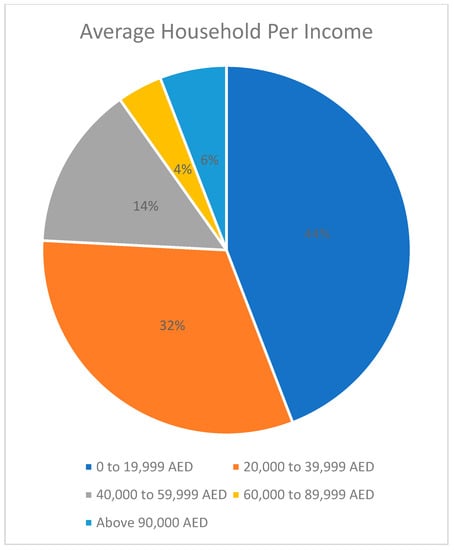
Figure 7.
Respondents’ average monthly income pie chart.
The residential tariffs in Abu Dhabi consist of two types as discussed previously, with variations in terms of electricity consumption tariffs between locals and expats. In this survey, 60% of respondents had the local tariff and 40% had the expat tariff, as shown in Figure 8.
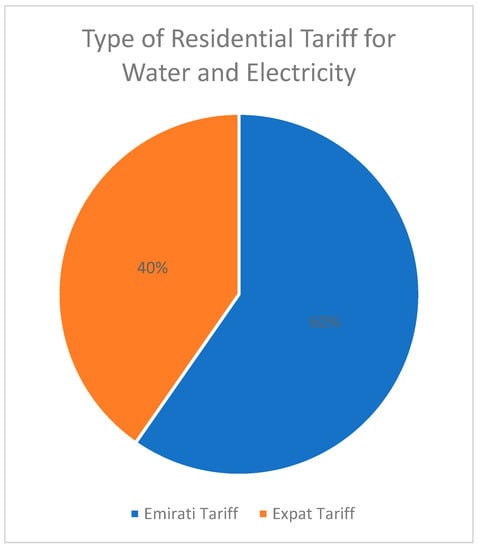
Figure 8.
Respondents’ residential tariff pie chart.
The survey also examined the general level of interest in the following subjects: environmental issues such as pollution, global warming, and overpopulation. The results show that only 4% of respondents were not at all interested, with 12% being not at all interested, 47% being moderately interested, and 41% of the respondents being extremely interested, as shown below in Figure 9.
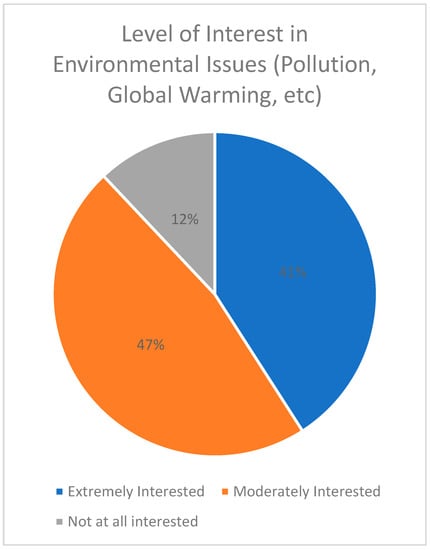
Figure 9.
Respondents’ level of interest in environmental issues pie chart.
The rate of interest of solar power as demonstrated by the pie chart below shows that the majority of the respondents were extremely interested as the responses consist of only 9% being not at all interested in solar energy, 41% being moderately interested, and 50% being extremely interested in solar energy; thus, the majority of the respondents in the city of Abu Dhabi. As shown in Figure 10.
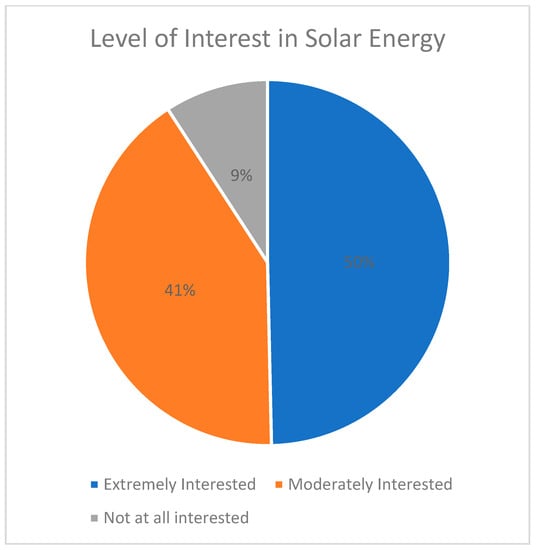
Figure 10.
Respondents’ rate of interest pie chart.
The survey highlights the opinion of the public on solar energy utilization schemes in Abu Dhabi. The majority of the respondents suggest that knowing the right information on solar energy materials is the most important factor for them to decide on buying and installing solar energy materials, where other respondents suggest that knowing the initial costs and return of investment from installing the solar energy materials are the most important factors to make their decision. However, only a minority of the respondents suggest that knowing the impact of solar energy materials on the environment is a prominent factor for them to decide, as demonstrated in Figure 11.
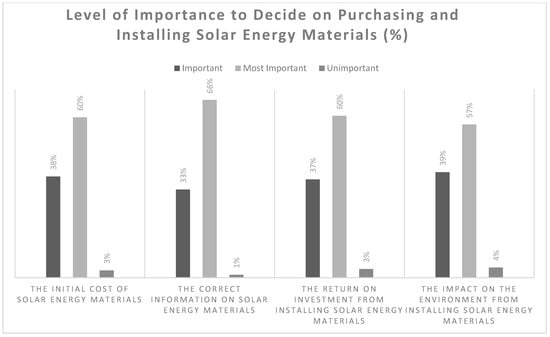
Figure 11.
Respondents’ level of importance to decide on purchasing and installing solar energy materials graph.
Additionally, many of the answers to the survey demonstrate an interest in solar power development for Abu Dhabi city and Al Ain. Remarkably, the majority of respondents believe that the government is the most important organization to promote solar energy in Abu Dhabi city, followed by research centers, higher education institutions, and, lastly, private organizations that have been proven, as per the surveyed respondents, to be the least important organization type to promote solar energy, as demonstrated in Figure 12.
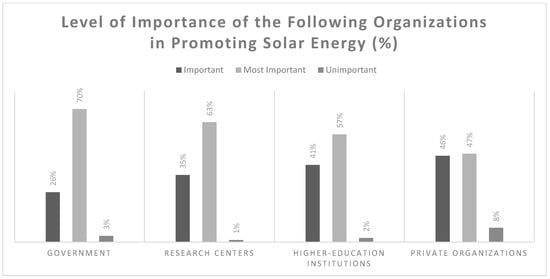
Figure 12.
Respondents’ level of importance of the following organizations in promoting solar energy graph.
The survey also questioned the respondents on the level of importance of the factors that can enhance the formulation of new solar energy policies in the city of Abu Dhabi. As per the majority of the respondents, one of the main factors in terms of importance is to increase public knowledge and awareness of solar energy, which will demand new policies to facilitate the expected and realistic scenarios to practically utilize solar energy. Likewise, the second major factor is to provide incentives for solar energy usage that will motivate the public accordingly, which will subsequently give birth to new policies that further regulate and develop the solar energy sector, while some respondents claim that establishing collaborations with developed countries to learn from their experience in solar energy is an important factor for developing new solar energy policies in Abu Dhabi. The results are demonstrated in Figure 13.
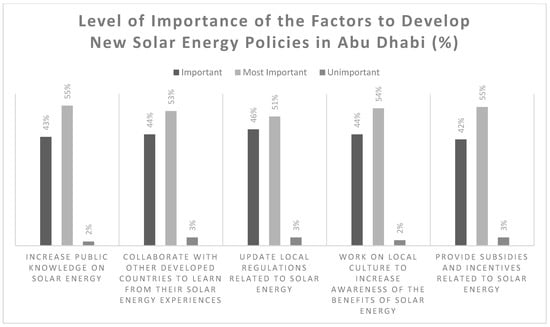
Figure 13.
Respondents’ level of importance of these factors to develop new solar energy policies graph.
Notably, the respondent’s most favorable scenario is to buy and implant solar panels for personal use if the cost is supported by the government through green energy initiatives that focus on solar energy in the city. However, the second favorable scenario is for homeowners to buy and install solar panels at their own expense if it will help them lower their monthly electricity bills and, consequently, save money. The third most favored scenario is for homeowners to buy and install solar panels, at their own expense, and then sell the produced solar energy to the government utility grid and pay the balance of their electricity usage on a yearly basis without having the need to consume the generated solar energy nor save it in batteries. Lastly, the least favored scenario among the four scenarios is for homeowners to buy and install solar panels at their own expense if this practice will help save the environment as well as save natural resources that are at risk of depletion. The results are demonstrated in Figure 14.
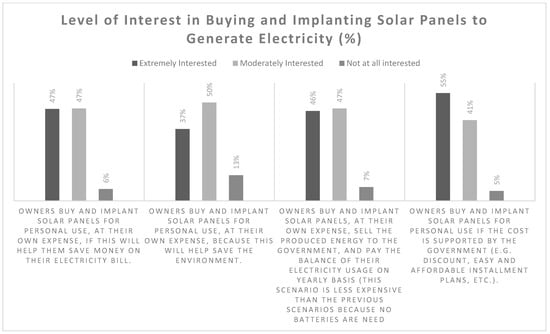
Figure 14.
Respondents’ level of interest in buying and implanting solar panels to generate electricity graph.
4.3. Statistical Data and Major Findings
The main objective of the survey was to understand the level of solar awareness and interest of homeowners in Abu Dhabi city, and, more importantly, to analyze the most appealing scenario that would stimulate homeowners to install solar power systems in their private homes. The survey focused on several aspects to ensure balanced results that support the preferred scenario, as listed in Table 3. For instance, social status questions were provided in the survey as well, which is a survey practice that affirms the participation results as coming from individuals of different backgrounds, genders, and financial statuses. The diversity of the surveyed individuals allowed the research paper to have a robust opinion about the most optimal scenario, established by dissimilar individuals instead of a similar group of people. Nonetheless, only interested individuals in the research study were selected for the survey; hence, the survey included a limited number of only 216 individuals. Moreover, the survey results do not aim to represent all the homeowners in Abu Dhabi city, but rather display a unified point of view that has the potential to be applied in the near future by homeowners.

Table 3.
This demonstrates the aspects that were covered in the survey.
Different financial and social status information was included in the survey. Income, for example, was important to highlight, as the solar panels differ in price depending on the electricity capacity, as was addressed previously. Thus, individuals with a low income are less likely to invest in solar panels. In addition, respondents’ gender was also required to affirm balanced survey results between male and female homeowners in Abu Dhabi city. The age range, as well, was required in the survey to further analyze the social acceptance levels of solar applications between the respondents of different age groups. Moreover, current electricity tariffs were provided to present an idea of the electricity generation costs and optimal usage, which currently impact homeowners. This study provides an overview of the current solar power applications in a specific region and how they can be further developed to be utilized by homeowners in Abu Dhabi city. In addition, it analyses the social acceptance of homeowners for solar applications, as demonstrated in Table 4. The knowledge in this research paper is proven by official statistical data on the optimal electricity consumption for the residents of the city, and the survey results as well, which are discussed in detail, to pave the way for future research to be initiated in accordance with the current research paper to allow greater utilization of solar panel systems in the private homes of Abu Dhabi city.

Table 4.
This presents the most and least accepted scenarios.
Following the received survey results, the majority of the respondents showed a respectable acceptance level for solar power. After identifying the general characteristics of the respondents, the survey displayed a set of questions regarding solar power awareness. Furthermore, the most appealing scenario that sounded applicable and suitable for homeowners was for the water and electricity authorities to provide a paid service for the installation of solar panels at private houses. Moreover, respondents found it to be more convenient for people interested in solar power if the authority provided a financial support program for the same group of people that, ultimately, would inspire more homeowners to invest in solar system installation at their private premises. Following the first scenario, respondents were relatively interested in scenarios that allowed them to cut electricity tariff costs, as well as being able to sell the produced solar power. The least preferred scenario was to install solar panels as a contribution to environmental initiatives.
4.4. Recommendations and Future Research
Despite Abu Dhabi’s vast solar energy potential, just a few open locations have been utilized to harvest solar electricity. Institutes’ and organizations’ nonparticipation is ascribed to a shortage of motivation. Furthermore, the difficulty is regarded as a crucial obstacle for UAE authorities to overcome unless communal engagement is fostered [53]. The government must explore the removal of consumer hurdles. Other consumer hurdles indicated by respondents include a demand for more information to raise awareness and a relative lack of interest that needs to be stimulated to encourage stakeholders to invest in photovoltaic systems. Solar energy awareness projects can be conducted through media channels such as publications, television, and social media. Nonetheless, efficient financial assistance is critical as well. The electricity authority in Abu Dhabi can help by enacting subsidies and price measures as consumption stimulation boosts demand and has the potential to broaden the market. Additionally, price strategy may involve bid rigging, which minimizes approval time when vendors meet predetermined prices and speeds up contract signing and project start-ups. Moreover, partnerships between governmental and commercial firms might be used as well to emphasize and support the establishment of a research and development infrastructure for solar energy studies in Abu Dhabi city [53]. The perception of consumers is highly dependent on the current aspects of the developing environmental and financial challenges, which adhere to the electricity generation processes that are being adopted in the city of Abu Dhabi. Evidently, the future vision of the UAE to enhance renewable energy consumption allows for more work to be invested in developing new solar energy technologies, to be utilized to achieve the goals the government has set to lessen carbon discharges and upsurge the production of sustainable energy, in order to meet the needs of consumers for electricity. Similarly, raising awareness and sharing insights on solar energy can allow developers and electricity component providers to broaden their provided services as well as encourage the integration of solar energy systems in newly built buildings.
5. Conclusions
This study restates the crucial importance of exploring different scenarios for homeowners in the city of Abu Dhabi to possess and utilize solar panels since the awareness of sustainable energy utilization is constantly increasing in the country. However, most of the electricity generated in the city of Abu Dhabi is dependent on natural gas combustion, which has several drawbacks such as durability and pollution. This study sheds light on the current electricity generation methods and risks [54]. It further investigates the different possible scenarios to generate solar energy independently at home, along with displaying the durability risks as well as addressing the social acceptance level of local residents to install solar panels in their houses. In addition, the study reveals public expectations and governmental policies on the implantation of solar panels for the government of Abu Dhabi. Furthermore, the survey results and discussion confirm the high public interest and awareness of solar energy. Based on the surveyed responses from the residents of Abu Dhabi city, the most preferred scenario that is deemed suitable by homeowners is for financial support and guidance from the authoritative parties of water and electricity in the city. Nonetheless, there are several major findings, such as:
- The majority of the respondents are interested in general environmental issues such as pollution and global warming.
- Ninety percent of the respondents in Abu Dhabi are interested in solar energy.
- The majority of respondents are interested in buying and implanting solar panels if the cost is supported by the government through installment plans, easy payment plans, and discounts.
- The majority of the respondents believe that increasing public knowledge of solar energy is important to develop new solar energy policies in Abu Dhabi.
- The majority of the respondents suggest that knowing the correct information on solar energy materials is important to decide on buying and installing solar energy panels, while others suggest knowing the initial cost is most important.
- The majority of the respondents claim that governmental organizations are important to promote solar energy, followed by research centers, higher education institutions, and lastly, private organizations.
- The current solar energy policies worldwide indicate that there is room for enhancement in the solar energy sector.
- The importance of solar energy research in research and development centers is emphasized to further analyze and develop new ways to utilize solar energy.
Author Contributions
Conceptualization, H.M.H. and K.R.; methodology, K.R.; software, H.M.H.; validation, K.R., M.A.T. and C.P.; formal analysis, K.R.; investigation, K.R. and H.M.H.; resources, H.M.H.; data curation, K.R.; writing—original draft preparation, H.M.H.; writing—review and editing, K.R.; visualization.; supervision, M.A.T.; project administration, C.P.; funding acquisition, H.M.H. All authors have read and agreed to the published version of the manuscript.
Funding
This research received no external funding.
Institutional Review Board Statement
This study describes research on humans. Therefore, approval from the Institutional Review Board of Abu Dhabi University was provided on the 19 September 2022. The approval code is COE-22-09-00030.
Informed Consent Statement
Informed consent was obtained from all subjects involved in the study.
Data Availability Statement
Not applicable.
Conflicts of Interest
The authors declare no conflict of interest.
Appendix A. Survey in English

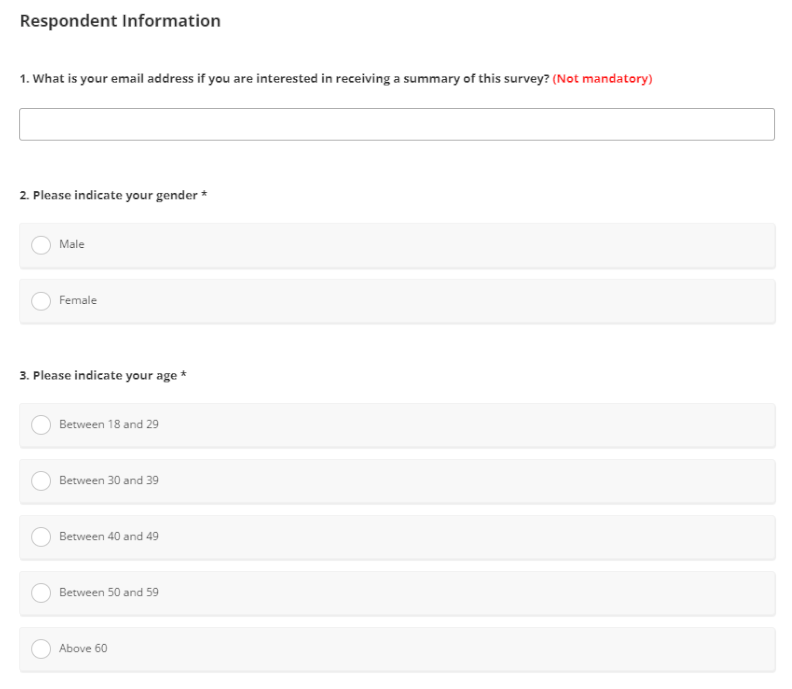
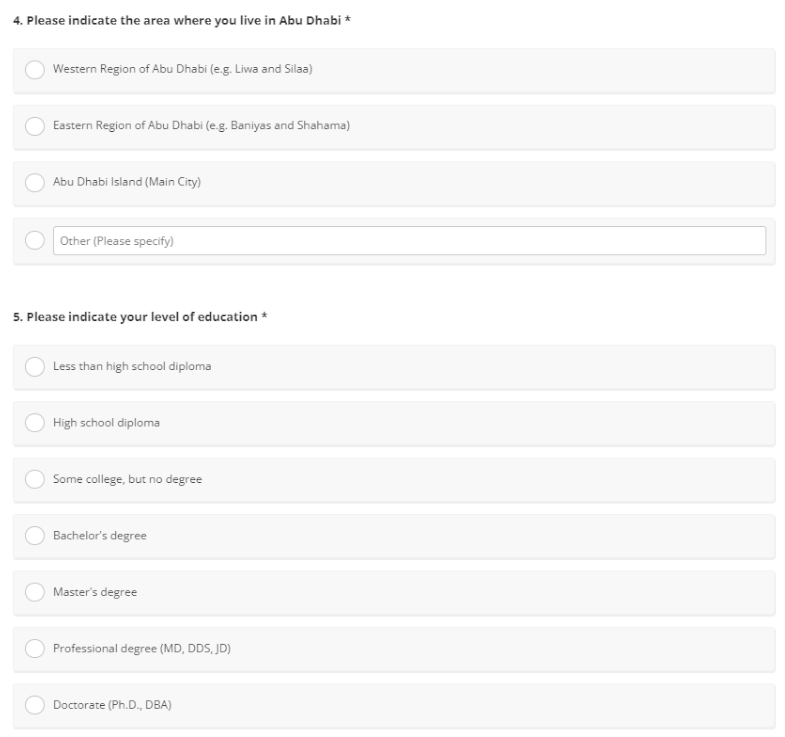

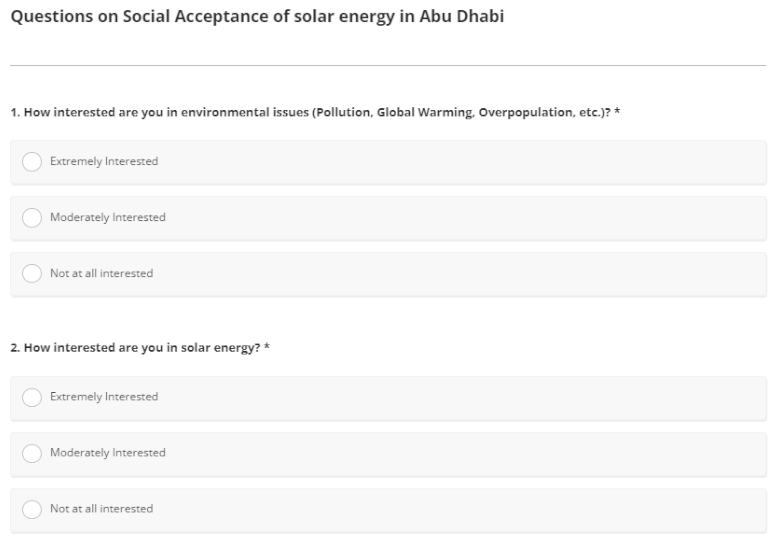

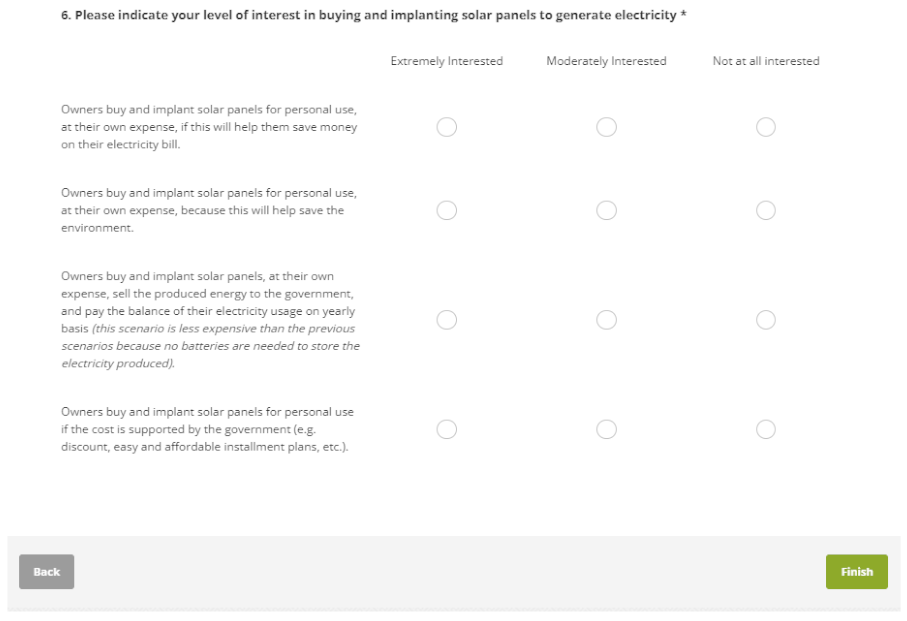
Appendix B. Survey in Arabic

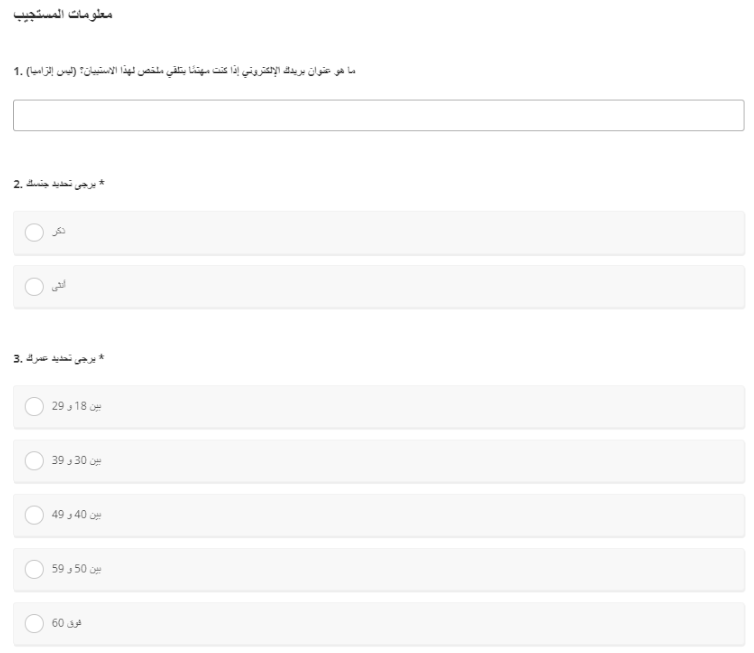
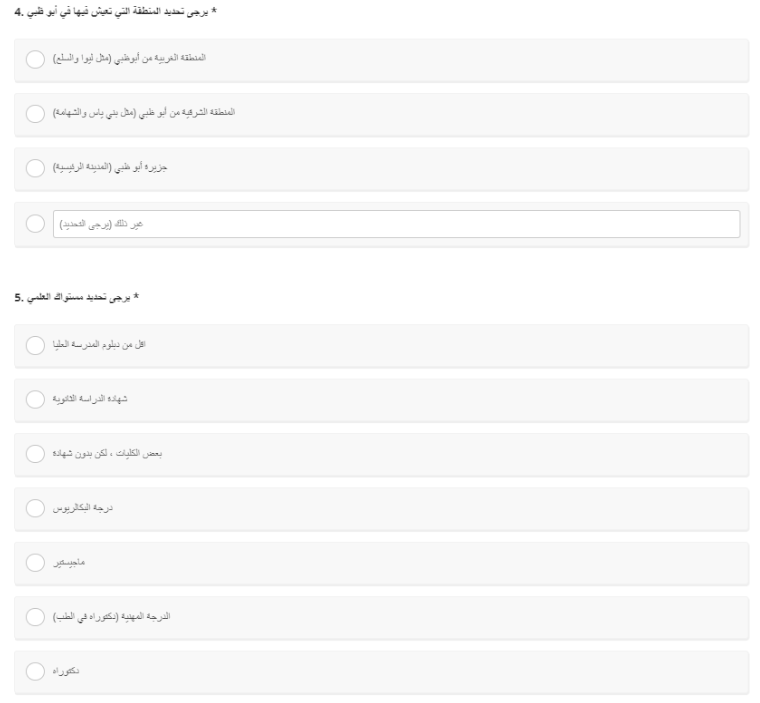
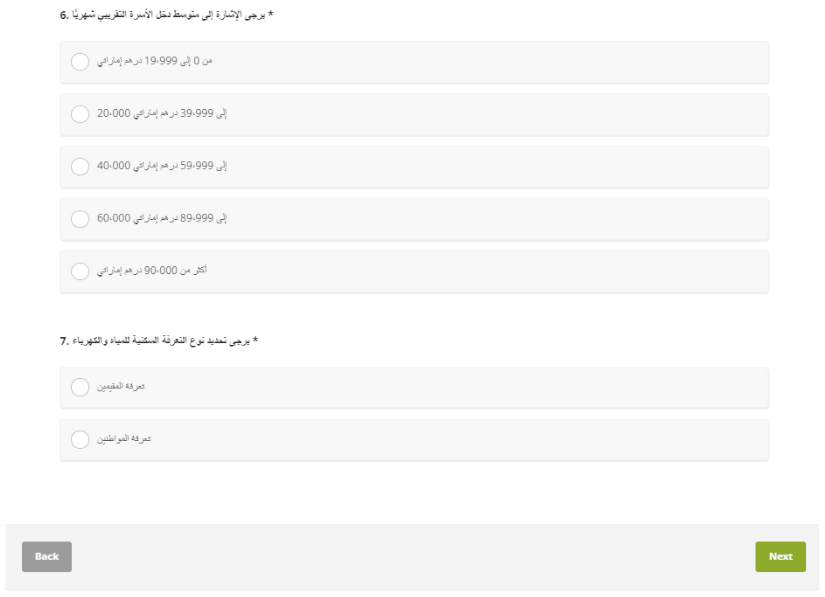
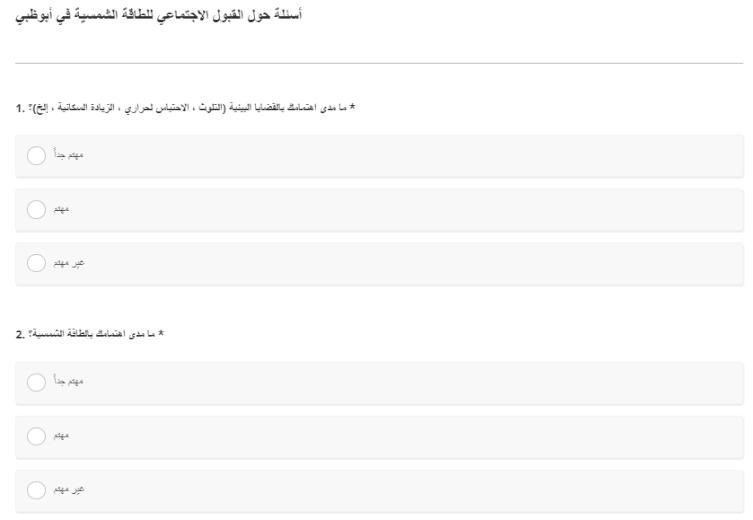
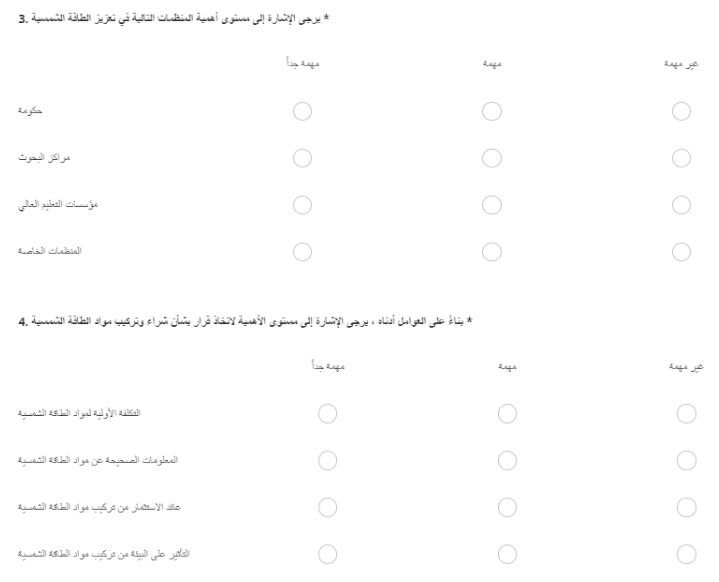
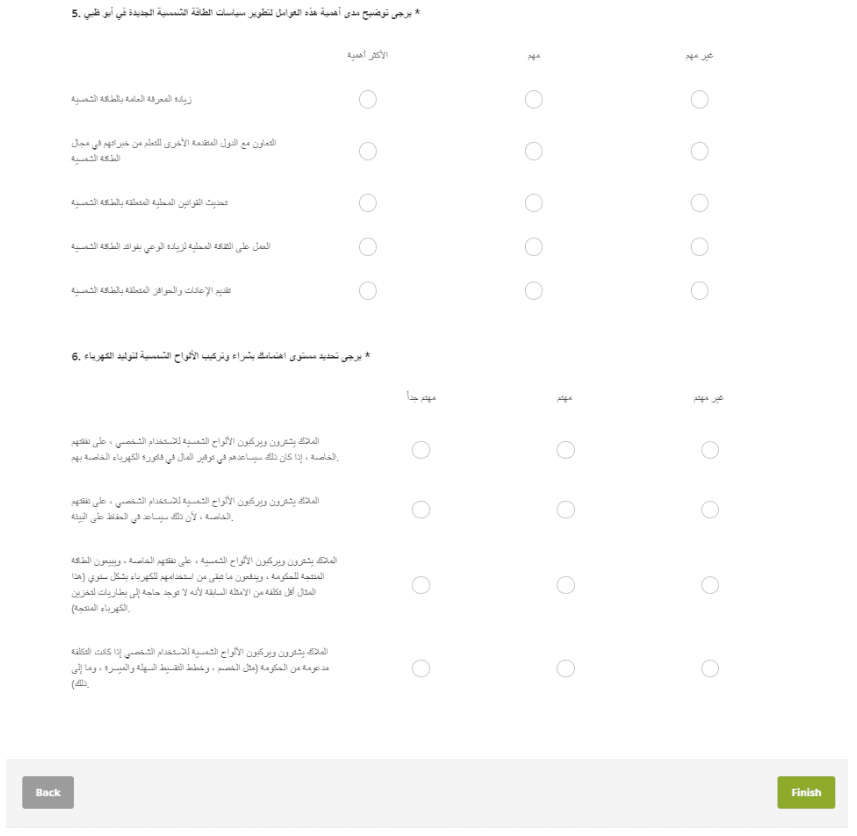
References
- International Trade Administration. United Arab Emirates—Renewable Energy. Available online: https://www.trade.gov/country-commercial-guides/united-arab-emirates-renewable-energy (accessed on 12 September 2021).
- Kazerani, M.; Tehrani, K. Grid of Hybrid AC/DC Microgrids: A New Paradigm for Smart City of Tomorrow. In Proceedings of the 2020 IEEE 15th International Conference of System of Systems Engineering (SoSE), Budapest, Hungary, 2–4 June 2020. [Google Scholar]
- Rahi, K.; Bourgault, M.; Preece, C. Risk and vulnerability management, project agility and resilience: A comparative analysis. Int. J. Inf. Syst. Proj. Manag. 2021, 9, 5–21. [Google Scholar] [CrossRef]
- Abu Dhabi Distribution Company. ADDC. Available online: https://www.addc.ae/en-US/home/Pages/AboutUs.aspx (accessed on 3 March 2019).
- Rahi, K.; Bourgault, M. Validation of a New Project Resilience Scale in the IT Sector. Proj. Manag. J. 2022, 53, 567–594. [Google Scholar] [CrossRef]
- Kaaya, I.; Koehl, M.; Mehilli, A.P.; Mariano, S.d.; Weiss, K.A. Modeling Outdoor Service Lifetime Prediction of PV Modules: Effects of Combined Climatic Stressors on PV Module Power Degradation. IEEE J. Photovolt. 2019, 9, 1105–1112. [Google Scholar] [CrossRef]
- Krishnamoorthy, M.; Periyanayagam, A.D.V.R.; Santhan Kumar, C.; Praveen Kumar, B.; Srinivasan, S.; Kathiravan, P. Optimal Sizing selection, and Techno-Economic Analysis of Battery Storage for PV/BG-based Hybrid Rural Electrification System. IETE J. Res. 2020. [Google Scholar] [CrossRef]
- Bazmi, A.A.; Zahedi, G. Sustainable energy systems: Role of optimization modeling techniques in power generation and supply—A review. Renew. Sustain. Energy Rev. 2011, 15, 3480–3500. [Google Scholar] [CrossRef]
- Casten, T.R.; Downes, B. Critical Thinking About Energy: The Case for Decentralized Generation of Electricity. Skept. Inq. 2005, 29, 25–33. [Google Scholar]
- Climate Council. Why Are Gas and Electricity Prices Going Up. 2022. Available online: https://www.climatecouncil.org.au/resources/explained-gas-electricity-prices-going-up/ (accessed on 9 September 2022).
- U.S. Energy Information Administration. Energy Explained. 2022. Available online: https://www.eia.gov/energyexplained/electricity/electricity-in-the-us.php (accessed on 15 July 2022).
- Macro Trends—Natural Gas Prices. Macro Trends—Natural Gas Prices. Available online: https://www.macrotrends.net/2478/natural-gas-prices-historical-chart (accessed on 9 September 2022).
- Technology and Power. Al Dhafra Solar Project, Abu Dhabi. Available online: https://www.power-technology.com/projects/al-dhafra-solar-project-abu-dhabi/ (accessed on 1 January 2020.).
- Eneh, O.C. A Review on Petroleum: Source, Uses, Processing, Products and the Environment. J. Appl. Sci. 2011, 11, 2084–2091. [Google Scholar] [CrossRef]
- James, P. Urban Sustainability in Theory and Practice: Circles of Sustainability; Routledge: London, UK, 2014; pp. 19–21. [Google Scholar]
- Shipley Energy. Green, Sustainable, Clean, and Renewable Energy—What Does It All Mean? Available online: https://www.shipleyenergy.com/resources/energy-guides/green-sustainable-clean-and-renewable-energy-what-does-it-all-mean (accessed on 15 September 2021).
- Nyholm, E.; Goop, J.; Odenberger, M.; Johnsson, F. Solar photovoltaic-battery systems in Swedish households—Selfconsumption and self-sufficiency. Appl. Energy 2016, 183, 148–159. [Google Scholar] [CrossRef]
- Mirasgedis, S.; Diakoulaki, D.; Papagiannakis, L.; Zervos, A. Impact of social costing on the competitiveness of renewable energies: The case of Crete. Energy Policy 2000, 28, 65–73. [Google Scholar] [CrossRef]
- Li, H.; Jenkins-Smith, H.C.; Silva, C.L.; Berrens, R.P.; Herron, K.G. Public support for reducing US reliance on fossil fuels: Investigating household willingness-to-pay for energy research and development. Ecol. Econ. 2009, 68, 731–742. [Google Scholar] [CrossRef]
- Wiser, R.H. Using contingent valuation to explore willingness to pay for renewable energy: A comparison of collective and voluntary payment vehicles. Ecol. Econ. 2007, 62, 419–432. [Google Scholar] [CrossRef]
- Del Río, P.; Burguillo, M. An empirical analysis of the impact of renewable energy deployment on local sustainability. Renew. Sustain. Energy Rev. 2009, 13, 1314–1325. [Google Scholar] [CrossRef]
- Varun; Prakash, R.; Bhat, I.K. Energy, economics and environmental impacts of renewable energy systems. Renew. Sustain. Energy Rev. 2009, 13, 2716–2721. [Google Scholar] [CrossRef]
- Abdullah, S.; Jeanty, P.W. Willingness to pay for renewable energy: Evidence from a contingent valuation survey in Kenya. Renew. Sustain. Energy Rev. 2011, 15, 2974–2983. [Google Scholar] [CrossRef]
- Diakoulaki, D.; Karangelis, F. Multi-criteria decision analysis and cost-benefit analysis of alternative scenarios for the power generation sector in Greece. Renew. Sustain. Energy Rev. 2007, 11, 716–727. [Google Scholar] [CrossRef]
- Zarnikau, J. Consumer demand for ‘green power’ and energy efficiency. Energy Policy 2003, 31, 1661–1672. [Google Scholar] [CrossRef]
- Zografakis, N.; Sifaki, E.; Pagalou, M.; Nikitaki, G.; Psarakis, V.; Tsagarakis, K.P. Assessment of public acceptance and willingness to pay for renewable energy sources in Crete. Renew. Sustain. Energy Rev. 2010, 14, 1088–1095. [Google Scholar] [CrossRef]
- Evans, A.; Strezov, V.; Evans, T.J. Assessment of sustainability indicators for renewable energy technologies. Renew. Sustain. Energy Rev. 2009, 13, 1082–1088. [Google Scholar] [CrossRef]
- Lazarou, S.; Pyrgioti, E.; Agoris, D. The latest Greek statute laws and its consequences to the Greek renewable energy source market. Energy Policy 2007, 35, 4009–4017. [Google Scholar] [CrossRef]
- Chang, J.; Leung, D.Y.C.; Wu, C.Z.; Yuan, Z.H. A review on the energy production, consumption, and prospect of renewable energy in China. Renew. Sustain. Energy Rev. 2003, 7, 453–468. [Google Scholar] [CrossRef]
- Bakos, G.C. Distributed power generation: A case study of small scale PV power plant in Greece. Appl. Energy 2009, 86, 1757–1766. [Google Scholar] [CrossRef]
- Agterbosch, S.; Meertens, R.M.; Vermeulen, W.J.V. The relative importance of social and institutional conditions in the planning of wind power projects. Renew. Sustain. Energy Rev. 2009, 13, 393–405. [Google Scholar] [CrossRef]
- Borchers, A.M.; Duke, J.M.; Parsons, G.R. Does willingness to pay for green energy differ by source? Energy Policy 2007, 35, 3327–3334. [Google Scholar] [CrossRef]
- Chalvatzis, K.J.; Hooper, E. Energy security vs. climate change: Theoretical framework development and experience in selected EU electricity markets. Renew. Sustain. Energy Rev. 2009, 13, 2703–2709. [Google Scholar] [CrossRef]
- Oikonomou, E.K.; Kilias, V.; Goumas, A.; Rigopoulos, A.; Karakatsani, E.; Damasiotis, M.; Papastefanakis, D.; Marini, N. Renewable energy sources (RES) projects and their barriers on a regional scale: The case study of wind parks in the Dodecanese islands, Greece. Energy Policy 2009, 37, 4874–4883. [Google Scholar] [CrossRef]
- Grilli, G. Renewable energy and willingness to pay: Evidences from a meta-analysis. Econ. Policy Energy Environ. 2017, 1, 253–271. [Google Scholar] [CrossRef]
- Stigka, E.K.; Paravantis, J.A.; Mihalakakou, G.K. Social acceptance of renewable energy sources: A review of contingent valuation applications. Renew. Sustain. Energy Rev. 2014, 32, 100–106. [Google Scholar] [CrossRef]
- Tarsheed. Tarsheed AD. 2020. Available online: https://www.tarsheedad.com/en-us/Pages/electricityconservation.aspx (accessed on 14 October 2021).
- World Future Energy Summit. Available online: https://www.worldfutureenergysummit.com/en-gb/exhibit.html (accessed on 5 April 2021).
- Albattah, M.; Attoye, D.E. A Quantitative Investigation on Awareness of Renewable Energy Building Technology in the United Arab Emirates. Sustainability 2021, 13, 6665. [Google Scholar] [CrossRef]
- Abu Dhabi Distribution Company (ADDC). 2020. Available online: https://www.addc.ae/en-US/residential/Pages/RatesAndTariffs2020.aspx (accessed on 5 April 2021).
- Ramachandran, T.; Abdel-Hamid, I.M.; Hamed, F. A Review on Solar Energy Utilization and Projects: Development in and around the UAE. Energies 2022, 15, 3754. [Google Scholar] [CrossRef]
- Knier, G. How Do Photovoltaics Work? Available online: https://science.nasa.gov/science-news/science-at-nasa/2002/solarcells (accessed on 6 August 2008).
- Afework, B.; Boechler, E.; Hanania, J.; Stenhouse, K.; Yyelland, B.; Donev, J. Photovoltaic Cells. 2021. Available online: https://energyeducation.ca/encyclopedia/Photovoltaic_cell (accessed on 27 September 2021).
- Energy, Alba. Solar Farms Are Popping up All across Texas. Available online: https://albaenergy.com/solar-farms-are-popping-up-all-across-texas/ (accessed on 2 May 2018).
- Wehrmann, B. Solar Power in Germany—Output, Business & Perspectives. Available online: https://www.cleanenergywire.org/factsheets/solar-power-germany-output-business-perspectives (accessed on 16 April 2020).
- LG. LG Solar Module Limited Warranty. Available online: https://www.lg.com/us/business/download/resources/BT00002151/BT00002151_2573.pdf (accessed on 15 September 2021).
- Gambone, S. LG Solar Panels vs. SunPower Solar Panels; Paradise Energy Solutions: Lancaster, UK, 2019. [Google Scholar]
- United Nations. What Is Renewable Energy? 2022. Available online: https://www.un.org/en/climatechange/what-is-renewable-energy (accessed on 19 July 2016).
- Gwandu, B.A.L.; Creasey, D.J. Humidity: A factor in the appropriate positioning of a Photovoltaic power station. Renew. Energy 1995, 6, 313–316. [Google Scholar] [CrossRef]
- Tan, C.M.; Chen, B.K.E.; Toh, K.P. Humidity study of a-Si PV cell. Microelectron. Reliab. 2010, 50, 1871–1874. [Google Scholar] [CrossRef]
- Kempe, M.D. Modeling of rates of moisture ingress into photovoltaic modules. Sol. Energy Mater. Sol. Cells 2006, 90, 2720–2738. [Google Scholar] [CrossRef]
- Sugimura, R.S.; Wen, L.C.; Mon, G.R.; Ross, R.S. Test techniques for voltage/humidityinduced degradation of thin-film photovoltaic modules. Solar Cells 1990, 28, 103–114. [Google Scholar] [CrossRef]
- Abuzaid, H.; Moeilak, L.A.; Alzaatreh, A. Customers’ perception of residential photovoltaic solar projects in the UAE: A structural equation modeling approach. Energy Strategy Rev. 2022, 39. [Google Scholar] [CrossRef]
- Lenzen, M. Current State of Development of Electricity-Generating Technologies: A Literature Review. Energies 2010, 3, 462–591. [Google Scholar] [CrossRef]
Publisher’s Note: MDPI stays neutral with regard to jurisdictional claims in published maps and institutional affiliations. |
© 2022 by the authors. Licensee MDPI, Basel, Switzerland. This article is an open access article distributed under the terms and conditions of the Creative Commons Attribution (CC BY) license (https://creativecommons.org/licenses/by/4.0/).